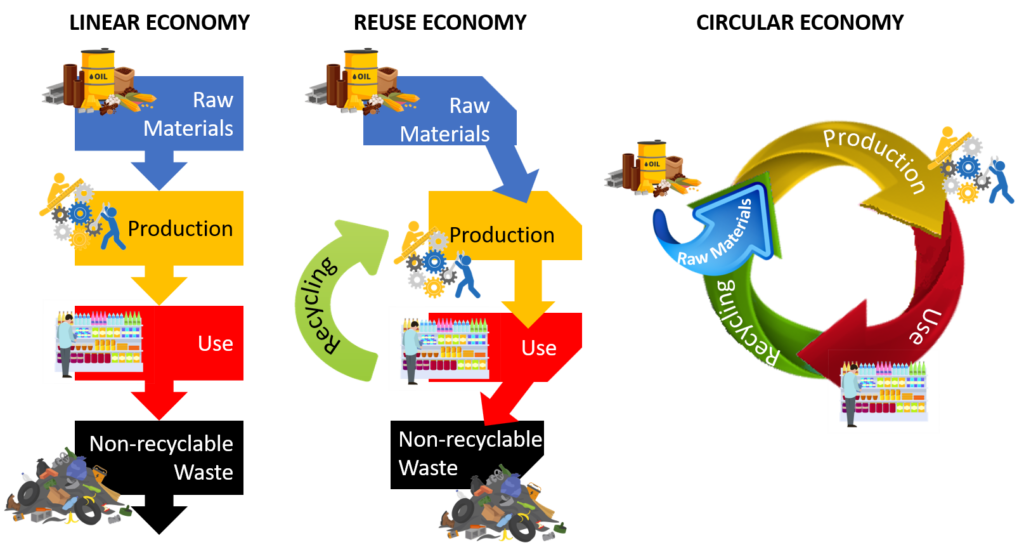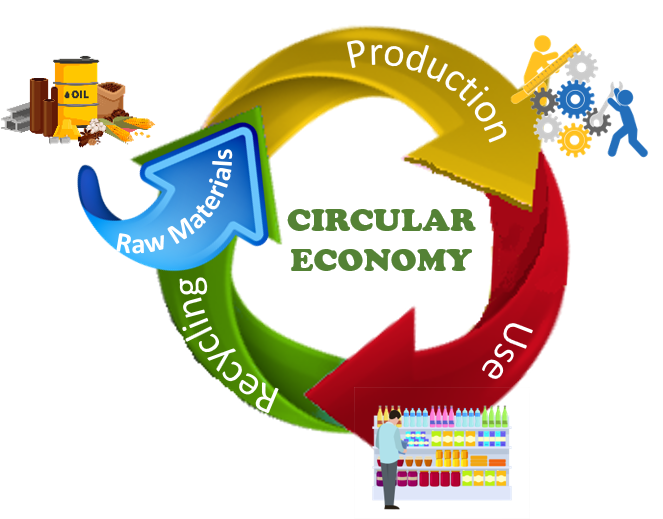The 26th Conference of Parties (COP26) held in mid-November 2021 in Glasgow once again, for a brief moment, focused world attention on the dangers of climate change and the importance taking long-term actions to mitigate its negative effects. One oft-discussed strategy to save the planet is transitioning to a circular economy. As the SmartCitiesWorld news team writes, “While the circular economy is still in its infancy, it is a key sustainability strategy being adopted by world and industry leaders in their fight against climate change.”[1] Although sporadic actions are taking place, it may be a bit strong (and optimistic) to assert the strategy “is being adopted by world and industry leaders.” Adopting a circular economy strategy will require a significant change of behavior in every person, business, and government in the world. That’s a tall order. The connective tissue of the circular economy is the supply chain. As MIT academics Alexis Bateman, Eva Ponce, and Inma Borrella, explain, “Circular supply chains are at the heart of efforts to tackle the massive environmental problems created by waste and end-of-life products.”[2]
What is a Circular Economy?
The Ellen MacArthur Foundation, a leading proponent of the circular economy, defines it this way: “The circular economy refers to an industrial economy that is restorative by intention; aims to rely on renewable energy; minimizes, tracks, and hopefully eliminates the use of toxic chemicals; and eradicates waste through careful design.” Former McKinsey analyst Markus Zils adds, “The circular economy aims to eradicate waste — not just from manufacturing processes, as lean management aspires to do, but systematically, throughout the life cycles and uses of products and their components. Indeed, tight component and product cycles of use and reuse, aided by product design, help define the concept of a circular economy and distinguish it from the linear take-make-dispose economy, which wastes large amounts of embedded materials, energy, and labor.”[3]
The staff at ModusLink adds, “The fundamental pillars of a circular economy are made of the term reusability. Instead of disposing of waste, waste materials are used through methods such as recycling, aiming to give purpose to waste. For example, during the creation of glass, the residue is formed that is normally disposed of. In a circular economy, this residue is again melted to create new glass. In this way, new raw materials are obtained in a sustainable way without damaging the environment or obstructing economic activity.”[4] They describe three economic models, with each model being more sustainable than the previous one. They are: the Linear Economy model; the Reuse Economy model; and the Circular Economy model. Most of the world still uses the Linear Economy model.

Jonquil Hackenberg, a Managing Partner at Infosys Consulting, insists, “If we’re serious about reducing the billions of tons of plastic and other waste that gets sent to landfill or pollutes our rivers and seas, we need the corporate world to come up with creative solutions that will enable us to enjoy our products — without further contributing to the environmental apocalypse.”[5] Without a supply chain supporting a circular economy, the model will never get off the ground. The ModusLink staff notes, “There are many Supply Chain elements where the Circular Economy concept can be integrated. These elements include Product Design, Procurement, Production, Logistics, Consumption, Waste management and Supply Chain Technology.”
Supply Chain Elements of a Circular Economy
A full-throated circular economy will require all of the following supply chain elements to be implemented. In the interim, efforts can be made in each area as stepping stones towards a more sustainable model.
Element 1. Product design. Georgia Wilson, a supply chain journalist, notes, “A circular economy is an economic model that encourages continuous reuse of materials to minimize waste, as well as driving demand for natural resource consumption.”[6] She cites a Gartner study that concludes, “The circular economy starts with good design, end of life and raw material reuse in mind.” The ModusLink staff adds, “Fundamentally altering product design can yield strong sustainability benefits. This is often best done when releasing/starting a new product, as big changes could take time to implement on scale. Sustainable packaging and product labelling is [also] a way to integrate the Circular Supply Chain concept.”
Element 2. Procurement. Most raw materials are finite resources. As the source of these materials becomes more difficult to obtain, procuring the resources necessary to produce products will a serious challenge. That’s why the ModusLink staff stresses reusability. They write, “Raw materials that are technically restorative or intrinsically reusable have a low negative environmental impact thus increasing sustainability within Supply Chains. The concept of acquiring such materials is often called ‘Green Procurement’. These materials increase the utilization rate and decrease waste generation.”
Element 3. Production. Reducing waste during manufacturing is good for both the manufacturer and the planet. The ModusLink staff observes, “Sustainable manufacturing practices are a great way to maintain a Circular Supply Chain. Although green production hasn’t been widely used (mostly due to cost-benefit comparing cheap labor), it certainly yields strong benefits when implemented correctly. Producing using renewable energy sources such as Solar Power reinforces a self-sustaining production process.”
Element 4. Logistics. Although e-commerce is gaining ground, it’s also creating a new sustainability challenge. Home delivery of packages adds to packaging requirements and waste as well as increased transportation costs (both real and environmental). The ModusLink staff notes, “Sustainably distributing products can be achieved through route optimization and avoiding concepts such as same-day delivery. It is important to be aware of your current logistical process.” Consumers are going to have to play a significant role in helping to make logistics more sustainable.
Element 5. Consumption. Consumers will also play a significant role in how products will be used and consumed in the future. The ModusLink staff writes, “Consumption is an interesting way to apply Circular Supply Chain Management as it has not been used until recently. It is predominantly gaining traction within the mobile phone industry where unwanted phones are returned to the respective company in return for discounts on newer models. Since new phones are often released on an annual basis, this is a great way for companies to regain their resources.”
Element 6. Waste Management. The reduction of waste is the single most important (and challenging) goal for a circular economy. According to the ModusLink staff, “Waste management [in an industrial setting] is essentially reusing waste material for your production process.” One small step toward improving waste management is the adoption of a new national recycling strategy announced in November 2021 by the Environmental Protection Agency. Journalist Justine Calma (@justcalma) reports, “It’s a roadmap for the US to achieve a goal of recycling at least half of its municipal waste by the end of the decade. That’s a steep rise considering the US’ recycling rate has actually declined since 2015, and was only at about 32 percent of all municipal waste in 2018 (the most recent year for which there’s EPA data).”[7] One current roadblock to many circular economy efforts is finding companies that can profitably use waste material in their production efforts. According to Calma, “The EPA wants to develop new markets for recycled materials so that it’s worth it for companies to recycle. That means there could be new policies or financial incentives on the way to boost demand for recycled materials.”
Element 7. Supply Chain Technology. According to the ModusLink staff, “The newest addition to integrating a Circular Supply Chain into a business is done through Sustainable Technology. This concept hasn’t been adopted on a wide scale as much technology is relatively new, however, some companies see the benefits gained from certain technology. Techniques and concepts such as IoT (Internet of things) and Additive manufacturing (3D printing) can yield strong benefits when adopted correctly.” Cognitive technologies can also help supply chains optimize processes, practices, and routing. Every improvement adds to the solution.
Concluding Thoughts
Although packaging wasn’t mentioned as a separate supply chain element in the previous discussion, packaging remains a big problem. And the biggest problem with packaging is plastic. Rachel Kenyon, Senior Vice President at Fibre Box Association, writes, “Everyone knows by now that plastics are jeopardizing the planet, especially oceans and marine life. There is heavy pressure on the plastics industry to develop new solutions and more recyclable options that could mitigate and slow down the damage. The current recovery rate for plastics is dismal at 9% and falling.”[8] You won’t be surprised to learn she supports greater use of cardboard packaging. She writes, “Paper-based packaging has always been a sustainable choice — safe for wildlife, degradable in the elements, nontoxic, and recyclable. Over 90% of corrugated boxes are recycled. The average box is recycled 7 times and contains over 50% recycled material. Corrugated packaging supports a ‘circular economy’ by minimizing raw material usage and energy consumption, plus robust recycling and reuse, including incorporation of recycled materials into new products.” Of course, environmentalists are concerned that greater use of paper-based products will add to deforestation. The point is, there are no easy answers — and we have a long way to go. The SmartCitiesWorld news team reports a study by ABI Research concluded, “The world will achieve 10.5 per cent circularity by 2030, as sustainability efforts and incoming legislation start to take effect.” Achieving the remaining 90% will take a gargantuan effort.
Footnotes
[1] News Team, “Circular economy is key sustainability strategy to fight against climate change, report finds,” SmartCitiesWorld, 29 October 2021.
[2] Alexis Bateman, Eva Ponce, and Inma Borrella, “Linear to Circular: Reshaping Supply Chains for a Sustainable Future,” MIT Center for Transportation & Logistics, 21 January 2020.
[3] Markus Zils, “Moving toward a circular economy,” McKinsey & Company, February 2014.
[4] Staff, “The Circular Economy,” ModusLink Blog, 2021.
[5] Jonquil Hackenberg, “How Circular Supply Chains Will Take Businesses From Landfill To Refill,” Forbes, 19 December 2019.
[6] Georgia Wilson, “Circular economy: the future of supply chain,” Supply Chain Digital, 27 February 2020.
[7] Justine Calma, “The US finally adopts a national recycling strategy,” The Verge, 15 November 2021.
[8] Rachel Kenyon, “Making the world go ’round: Circularity in supply chains,” Supply Chain Dive, 9 August 2021.





